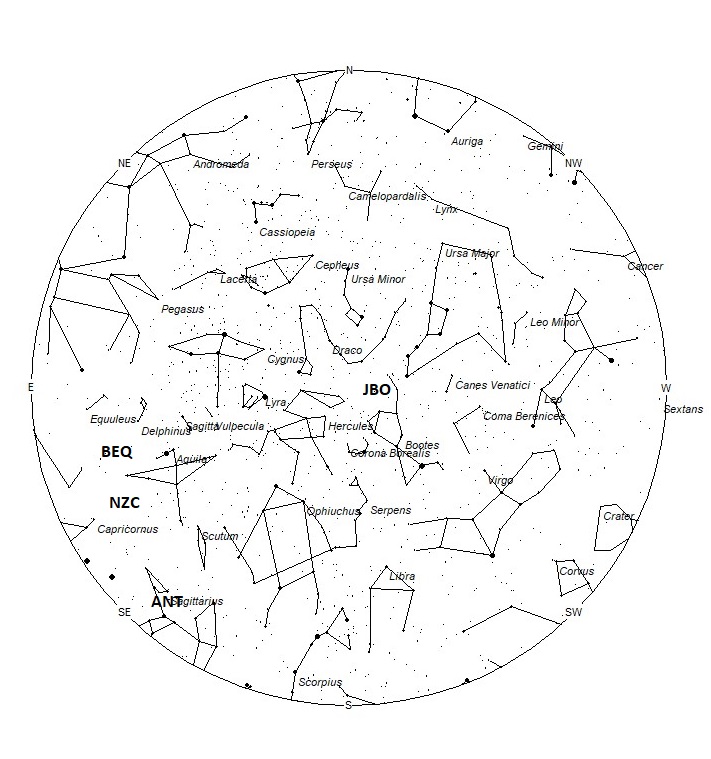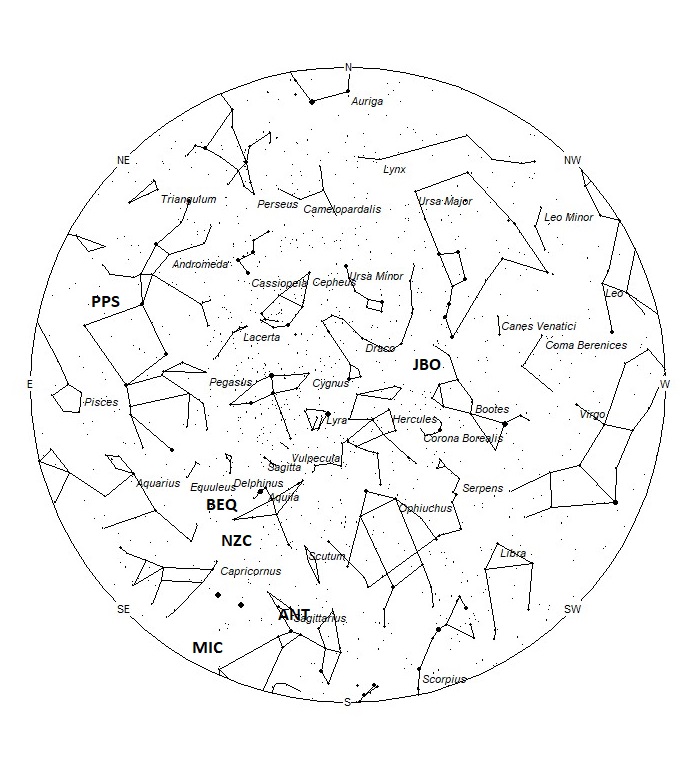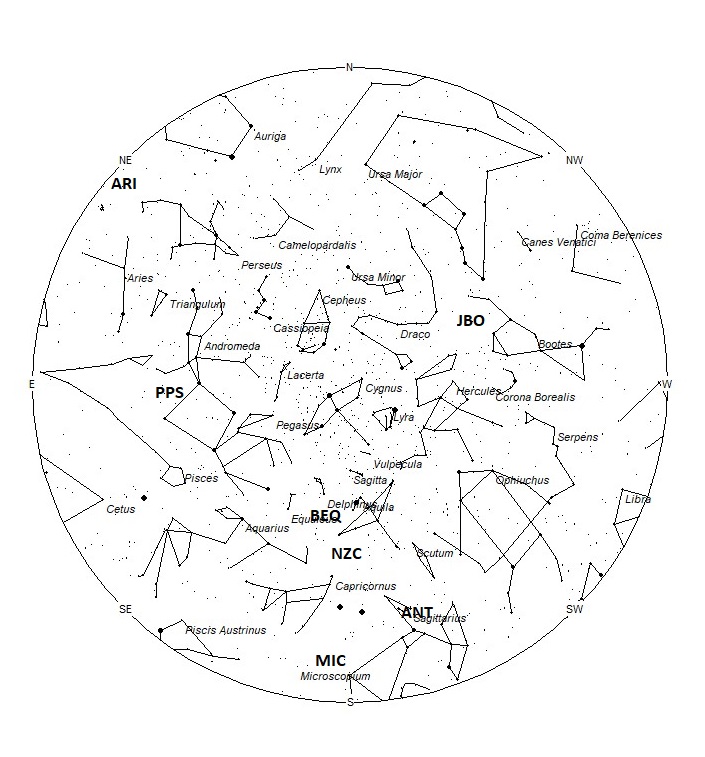During this period the moon reaches its new phase on Monday June 22nd. At this time, the moon is located near the sun and it invisible at night. As the week progresses the waxing crescent moon will enter the evening sky but will not interfere with meteor observing. The estimated total hourly meteor rates for evening observers this week is near 3 for those viewing from the northern hemisphere and 4 for those located south of the equator. For morning observers, the estimated total hourly rates should be near 11 as seen from mid-northern latitudes (45N) and 15 as seen from tropical southern locations (25S). The actual rates will also depend on factors such as personal light and motion perception, local weather conditions, alertness, and experience in watching meteor activity. Note that the hourly rates listed below are estimates as viewed from dark sky sites away from urban light sources. Observers viewing from urban areas will see less activity as only the brighter meteors will be visible from such locations.
The radiant (the area of the sky where meteors appear to shoot from) positions and rates listed below are exact for Saturday night/Sunday morning June 20/21. These positions do not change greatly day to day so the listed coordinates may be used during this entire period. Most star atlases (available at science stores and planetariums) will provide maps with grid lines of the celestial coordinates so that you may find out exactly where these positions are located in the sky. A planisphere or computer planetarium program is also useful in showing the sky at any time of night on any date of the year. Activity from each radiant is best seen when it is positioned highest in the sky, either due north or south along the meridian, depending on your latitude. It must be remembered that meteor activity is rarely seen at the radiant position. Rather they shoot outwards from the radiant, so it is best to center your field of view so that the radiant lies at the edge and not the center. Viewing there will allow you to easily trace the path of each meteor back to the radiant (if it is a shower member) or in another direction if it is a sporadic. Meteor activity is not seen from radiants that are located far below the horizon. The positions below are listed in a west to east manner in order of right ascension (celestial longitude). The positions listed first are located further west therefore are accessible earlier in the night while those listed further down the list rise later in the night.
The radiant (the area of the sky where meteors appear to shoot from) positions and rates listed below are exact for Saturday night/Sunday morning June 6/7. These positions do not change greatly day to day so the listed coordinates may be used during this entire period. Most star atlases (available at science stores and planetariums) will provide maps with grid lines of the celestial coordinates so that you may find out exactly where these positions are located in the sky. A planisphere or computer planetarium program is also useful in showing the sky at any time of night on any date of the year. Activity from each radiant is best seen when it is positioned highest in the sky, either due north or south along the meridian, depending on your latitude. It must be remembered that meteor activity is rarely seen at the radiant position. Rather they shoot outwards from the radiant so it is best to center your field of view so that the radiant lies at the edge and not the center. Viewing there will allow you to easily trace the path of each meteor back to the radiant (if it is a shower member) or in another direction if it is a sporadic. Meteor activity is not seen from radiants that are located below the horizon. The positions below are listed in a west to east manner in order of right ascension (celestial longitude). The positions listed first are located further west therefore are accessible earlier in the night while those listed further down the list rise later in the night.
These sources of meteoric activity are expected to be active this week.
.
The June Bootids (JBO) are usually a very weak shower that occasionally produces outbursts. Nothing out of the ordinary is expected this year. These meteors are best seen from June 25-29 with maximum activity occurring on the 27th. At maximum the radiant is located at 14:48 (223) +48. This position lies in northwestern Bootes, 15 degrees east of the 2nd magnitude star known as Alkaid (Eta Ursae Majoris). This radiant is best placed in the evening sky just as the sky becomes dark. Observers in the northern hemisphere have a distinct advantage over those located south of the equator as the radiant lies much higher in the evening sky. No matter your location, little activity is expected from this source. With an entry velocity of 14 km/sec., the average June Bootid meteor would be of very slow velocity.
The center of the large Anthelion (ANT) radiant is currently located at 18:48 (282) -23. This position lies in northern Sagittarius, 4 degrees north of the 2nd magnitude star known as Nunki (sigma Sagittarii). Due to the large size of this radiant, Anthelion activity may also appear from southern Scutum as well as Sagittarius. This radiant is best placed near 0200 local summer time (LST), when it lies on the meridian and is located highest in the sky. Rates at this time should be near 2 per hour as seen from mid-northern latitudes (45 N) and 3 per hour as seen from the southern tropics (S 25). With an entry velocity of 30 km/sec., the average Anthelion meteor would be of slow velocity.
The Northern June Aquilids (NZC) were discovered by Zdenek Sekanina in 1976. These meteors are active from a radiant located at 19:53 (298) -08. This area of the sky is located in southern Aquila, 8 degrees northwest of the 4th magnitude star known as Algedi (α² Capricorni). This radiant is best placed near 0200 LST, when it lies on the meridian and is located highest in the sky. Hourly rates at this time should be near 1 no matter your location. With an entry velocity of 38 km/sec., the average meteor from this source would be of medium-slow velocity. An interesting fact about this source is that it may be related to the Northern delta Aquariids of August. Where and when this source ends coincides with the start and position of the Northern delta Aquariids.
The Microscopiids (MIC) were discovered by G. Gartrell and W. G. Elford, in their study of Southern Hemisphere meteor streams. This stream is active from June 9 through July 17 with maximum activity occurring on July 5. The radiant is currently located at 20:14 (303) -32. This area of the sky is actually located in eastern Sagittarius, 4 degrees northeast of the 4th magnitude star known as theta1 Sagittarii. This radiant is best placed near 0200 LST, when it lies on the meridian and is located highest in the sky. Hourly rates at this time should be less than 1 no matter your location. With an entry velocity of 39 km/sec., the average meteor from this source would be of medium-slow velocity. This shower is synonymous with the Southern June Aquilids (SZC).
The beta Equulids (BEQ) were discovered by Dr. Peter Brown and associates using data from the Canadian Meteor Orbit Radar (CMOR) installation. These meteors are active from June 7-30 with maximum activity occurring on June 14th. The radiant position currently lies at 20:30 (308) +02. This area of the sky lies in southeastern Aquila, 4 degrees northeast of the 3rd magnitude star known as Tseen Foo (theta Aquilae). This radiant is best placed near 0300 LST, when it lies on the meridian and is located highest in the sky. Hourly rates are expected to be less than 1, no matter your location. With an entry velocity of 33 kilometers per second, a majority of these meteors will appear to move with medium-slow velocities. Being discovered by radar, these meteors may be faint and difficult to observe by visual observing.
The phi Piscids (PPS) are another discovery by Dr. Peter Brown and associates using data from the Canadian Meteor Orbit Radar (CMOR) installation. These meteors are active from June 8-August 02 with maximum activity occurring on July 4th. The radiant position currently lies at 00:20 (005) +20. This area of the sky lies in southeastern Pegasus, 5 degrees northeast of the 3rd magnitude star known as Algenib (gamma Pegasi). These meteors are best seen near during the last dark hour of the night when the radiant lies highest in a dark sky. Hourly rates are expected to be less than 1 no matter your location. With an entry velocity of 67 kilometers per second, a majority of these meteors will appear to move with swift velocities.
The last of the Daytime Arietids (ARI) are expected this week. These meteors are difficult to catch as the radiant only lies 30 degrees west of the sun. Therefore, the only time these meteors are visible is during the last dark hour before dawn. The radiant is currently located at 04:00 (060) +27. This area of the sky is located in western Taurus, 4 degrees northeast of the naked eye open cluster known as the Pleiades. Current rates are expected to be less than 1 no matter your location. With an entry velocity of 41 km/sec., the average meteor from this source would be of medium velocity.
As seen from the mid-northern hemisphere (45N) one would expect to see approximately 7 sporadic meteors per hour during the last hour before dawn as seen from rural observing sites. Evening rates would be near 2 per hour. As seen from the tropical southern latitudes (25S), morning rates would be near 9 per hour as seen from rural observing sites and 3 per hour during the evening hours. Locations between these two extremes would see activity between the listed figures.
The list below offers the information from above in tabular form. Rates and positions are exact for Saturday night/Sunday morning except where noted in the shower descriptions.
| SHOWER | DATE OF MAXIMUM ACTIVITY | CELESTIAL POSITION | ENTRY VELOCITY | CULMINATION | HOURLY RATE | CLASS |
| RA (RA in Deg.) DEC | Km/Sec | Local Summer Time | North-South | |||
| June Bootids (JBO) | Jun 27 | 14:48 (223) +48 | 30 | 22:00 | <1 – <1 | III |
| Anthelion (ANT) | – | 18:48 (282) -23 | 30 | 02:00 | 2 – 3 | II |
| Northern June Aquilids (NZC) | Jul 02 | 19:53 (298) -08 | 41 | 03:00 | 1 – 1 | IV |
| Microscopiids (MIC) | Jul 05 | 20:14 (303) -32 | 39 | 03:00 | <1 – 1 | IV |
| beta Equulids (BEQ) | Jun 14 | 20:30 (308) +02 | 33 | 04:00 | <1 – <1 | IV |
| phi Piscids (PPS) | Jul 04 | 00:20 (005) +20 | 67 | 08:00 | 1 – 1 | IV |
| Daytime Arietids (ARI) | Jun 07 | 04:00 (060) +27 | 41 | 11:00 | <1 – <1 | I |





L.S.
When you state Hourly Rates. are these ZENITH hourly rates or otherwise?
Thx
Jan and All,
The rates listed in these articles are the actual rates one can expect to see. That is why they are on the low side. I feel that listing ZHR’s would lead the potential observer to expect higher activity which is unrealistic.
Hi Robert,
I think you might have a bit more confidence in the discernment of your readers. The hourly rate is primarily dependent on the sinus of the angle of incidence, and therewith on the observer’s geographical latitude. And they are to be found anywhere on the globe, I assume.